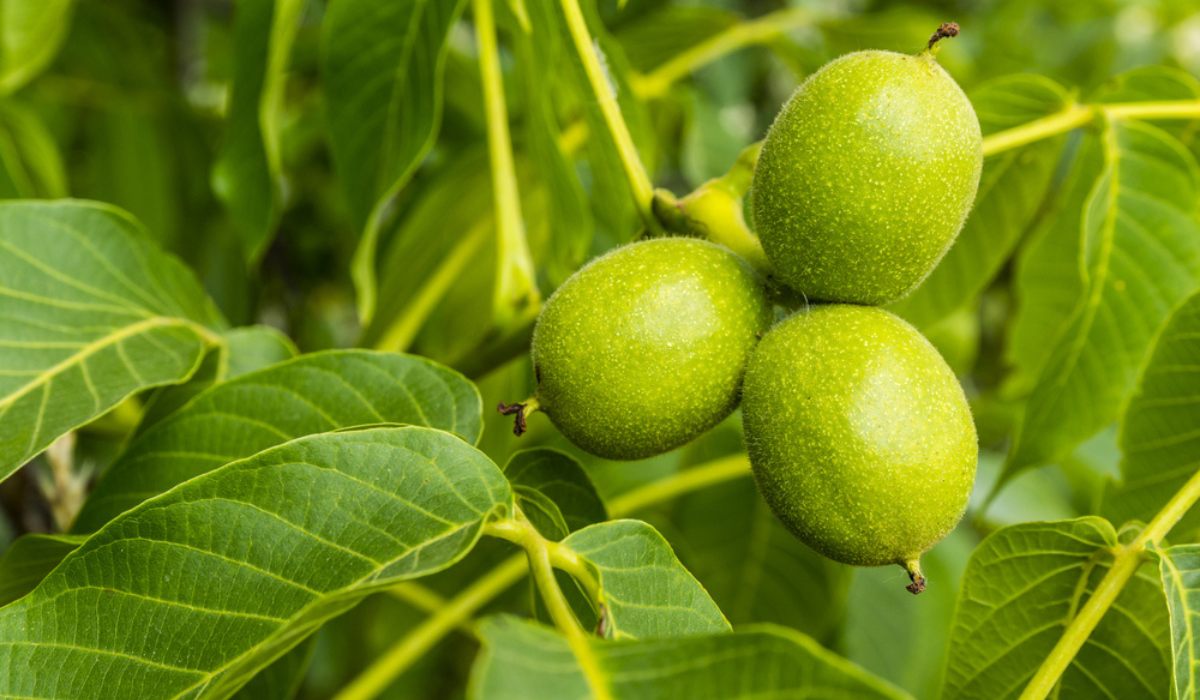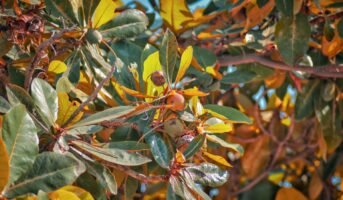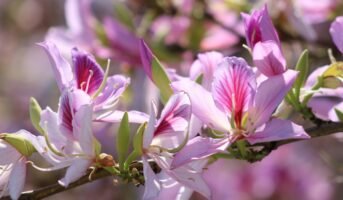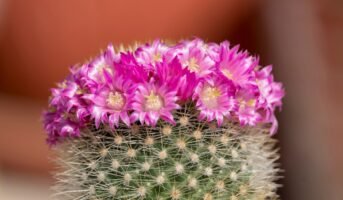Juglans regia is a huge tree that is known for its nutrient-rich fruit. It is a variety of walnut and is known by its common names Persian walnut, English walnut, Carpathian walnut, Madeira walnut, and common walnut. This tree finds its origin in the Balkans in Europe and the Himalayas, and China in Asia. Today, it is an important tree in Europe and is widely cultivated across the continent. mahogany, teak, walnut,
Check these facts about Dioscorea bulbifera or the air potato

Source: Pinterest
The tree itself can rise to a staggering height of 50 feet and sometimes may even cross 100 feet. A mature walnut tree will be huge in size and is often used for wood and timber manufacturing. The tree flowers in spring to produce fruits that contain walnuts. The tree bears male flowers in drooping catkins and female flowers that appear in clusters.
Juglans regia: Key facts
| Name | Juglans regia |
| Common name | English walnut, Persian walnut |
| Type | Deciduous tree |
| Origin | The Balkans, the Himalayas and southwest China. |
| Indoor/Outdoor | Outdoor |
| Soil | Light sandy or clayey soil |
| Temperature | 15-20°C |
| Sunlight | Full sunlight |
| Water | Regularly |
| Placement | Yard, garden, pastures, lawns |
| Height | 40-60 feet |
| Fruit | Round, green, with walnuts inside |
Juglans regia: How to grow
Juglans regia typically grows in swampy areas but can also be found in wet fields and other wetlands. It’s considered an important tree for wildlife habitat, as it provides shelter and food for many birds, including woodpeckers and owls. Juglans regia also provides valuable lumber for building homes, furniture, and other items.
Growing Juglans regia plants requires a great deal of care. It’s best to plant the trees during spring or fall when the soil temperature is between 15-22 degrees Celsius. The soil should have plenty of organic matter (such as compost) to enrich its nutrient content so that it can be used by the plant.
The ideal pH level for planting Juglans regia trees is between 5.5 and 6.5; anything below this number will cause your tree’s leaves to turn yellow or brown before they die off altogether during winter cold weather conditions.
See also: Tips for an indoor garden design
Juglans regia: Maintenance tips
- Juglans regia is a hardy tree that can grow in almost any climate. It does best in full sun or partial shade, but it will tolerate some shade.
- The best time to plant Juglans regia is in early spring or late fall when temperatures are between 16°C and 21°C.
- The tree requires well-drained soil and regular watering, but it will not tolerate wet soils.
- Juglans regia tolerates drought well but needs more water during the summer months than in winter.
- Be sure to water your tree at least once a week during hot weather.
- If you live in an area with frosty winters, you should mulch your tree’s leaves to help prevent damage from cold winds and snow accumulation on its branches.
Juglans regia: Uses
Juglans regia is an extremely important plant that has more uses than meets the eye. It is spread across Europe and is used for several manufacturing purposes. Walnuts from Juglans regia are popular and are consumed around the world. Moreover, Juglans regia can live up to 150 years.
However, the entire tree is extremely useful and can be profitable for the grower.

Source: Pinterest
Here are some of the major uses of Juglans Regia:-
- The trunk and branches from Juglans regia are useful in the manufacturing of wood, paper, ply, and timber.
- The walnuts from Juglans regia are consumed worldwide and are used to create a variety of cuisines.
- Walnut extracts are highly used in cosmetic and skincare products.
- Walnut oil is used to make hair care products.
Juglans regia: Benefits
Juglans regia is known to produce walnuts. Walnuts themselves are extremely popular as dry fruits and are known for their several health benefits. They can be consumed to improve brain activity, and their rich nutrients help strengthen muscles. Walnut bark also has several medicinal properties, so having this tree at home can be extremely beneficial for you.

Source: Pinterest
Here are some of the top health benefits of Juglans regia that you should know:-
Improves heart health
Walnuts are said to improve heart health in many ways. They are known to decrease low-density lipoprotein (LDL) cholesterol that prevents the clogging of arteries. Additionally, they help balance blood pressure and reduce oxidative stress. Their anti-inflammatory characteristic helps in controlling the inflammation of the arteries and prevents the risk of cardiovascular diseases.
Treats diabetes
Walnuts are ideal snacks that might help to reduce blood sugar levels. Studies have revealed that walnut consumption can indicate a lower risk of type 2 diabetes in women. Therefore, people who have blood sugar problems can take walnuts to improve their health.
Stimulates brain activity
Walnut consumption can help to increase serotonin levels in the brain. This chemical is known to help the body convey signals from one area of the brain to another. This allows a person to have an improved learning ability and a great memory. Children are especially recommended to eat walnuts for better memory.
Reduces obesity
Walnut is an excellent source of protein and dietary fibre. These nutrients are extremely important for decreasing fat absorption. They keep the stomach full and avoid overeating. Additionally, they help burn fat faster and aid in weight loss.
Antioxidant properties
Walnut contains phenolic compounds that can help perform antioxidant functions. Additionally, it helps remove harmful radicals from the body that can cause several diseases.
Cures fatigue
Walnuts can help provide energy to the body and reduce fatigue levels. It has several nutrients that help in energy formation and keeps the body active for a long time.
Improves oral hygiene
Walnut bark is known to act against microbes like Staphylococcus aureus, Streptococcus mutans, Escherichia coli, Pseudomonas aeruginosa, and the yeast Candida albicans. Additionally, it can be helpful in curing gum infections and reducing plaque formation in the teeth.
Helps gut microbiota
Walnuts are said to help increase the number of healthy bacteria that is found in the gut. These bacteria fight against various gastrointestinal diseases and help maintain gut health.
Aids to improve mental health
Walnuts help produce serotonin in the brain. They are also an excellent source of omega-3 polyunsaturated fatty acids (PUFA), Vitamin E, polyphenols, and melatonin. These compounds can influence the brain and help to improve mood and eliminate depression, and anxiety.
FAQs
What is Juglans regia used for?
Juglans regia is extremely useful for making medicines. It was used in ancient times to find the cure for dysentery, helminthiasis, diseases, arthritis, etc.
What is the common name of Juglans regia?
Juglans regia is also known by its common names like English walnut and Persian walnut.
Are Persian walnuts edible?
Persian walnuts are completely edible. They are even sold in supermarkets for high prices due to their amazing taste and quality.
Housing News Desk is the news desk of leading online real estate portal, Housing.com. Housing News Desk focuses on a variety of topics such as real estate laws, taxes, current news, property trends, home loans, rentals, décor, green homes, home improvement, etc. The main objective of the news desk, is to cover the real estate sector from the perspective of providing information that is useful to the end-user.
Facebook: https://www.facebook.com/housing.com/
Twitter: https://twitter.com/Housing
Email: [email protected]











